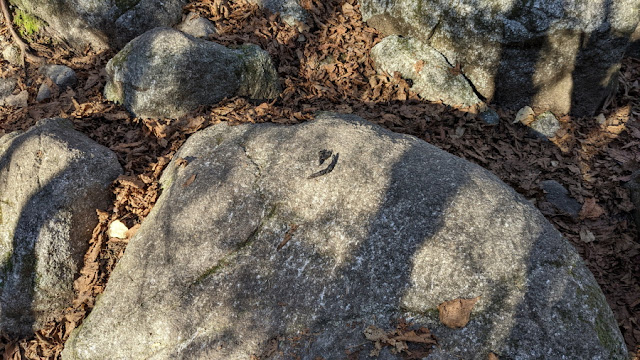There were a lot of feathered creatures out celebrating Thanksgiving this week: woodpeckers, goldeneyes, mallards, geese - but none that I saw were turkeys. Of these, the most interesting to watch was the pileated woodpecker. It caught my eye as it flew, the flashes of white in its wings divulging its identity, and it was easy to follow it to its destination on an oak tree with a promising rotten spot on a large branch.
 |
| This branch caught the pileated's trained eye. |
It hopped up on the branch and listened for signs of life inside the decaying wood.
 |
| The red stripe on the cheek indicates this is a male. Females have a black stripe. |
He apparently found what he was looking for and pinpointed the exact spot to attack.
 |
| Right there, in that little gap surrounded by lichen. |
He began his assault, chopping at the branch with long strokes of his powerful neck, up and down, up and down. First he broke through the bark, making a small mark on the branch.
Woodpeckers use their strong tail as a third contact point to brace against as they drive their chisel into the wood. This video, though blurry and out of focus, at least shows the force a pileated can apply to its work. Note how he keeps his tail pressed against the tree, and stops to listen now and then:
As he worked, the hole enlarged and deepened.
Soon he broke through the outer wood and opened up a pathway to the insects' home inside, most likely a nest of carpenter ants, at which point he simply stuck his beak in the hole, pushing his sticky, barbed tongue into the nest - a pileated can extend its tongue out two inches - pulling out ant after ant, and maybe some eggs too.
He sat for long time feasting on the high protein food inside.The whole process, from when he landed to when he got his first morsel took just five minutes. Here's a video of him reaping the fruits of his labor.
The next bird encounter came on Thursday morning when we took a walk along the WOW Trail between Laconia and Lakeport to rev up our appetite for Thanksgiving dinner. There in Opechee Bay was a huge gaggle of goldeneyes that had gathered for their own Thanksgiving celebration - over 30 of them.
 |
| Goldeneyes, thankful for making it unscathed through the first half of hunting season. |
 |
| Or perhaps being chased by the flock? |
 There were also a few mallards in the bay.
There were also a few mallards in the bay. |
| Mrs. Mallard stretches her wings. |
Lastly, I'll share some pictures of needle ice that I found on a run up to the White Mountain Ledge in the Hamlin Town Forest. I keep my eye out for this on the first cold days of the year, but these were easy to find as they were right in the middle of the trail.
 |
| Needle ice on the Red Trail leading to the White Mountain Ledge |
The intersection of water and cold always fascinates me.







































